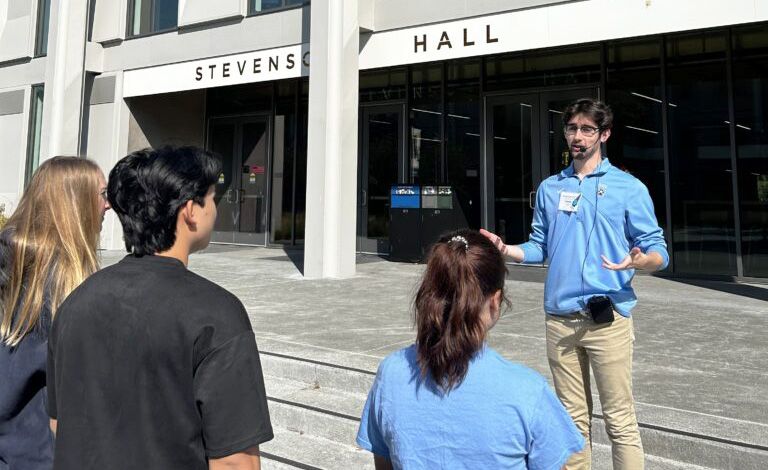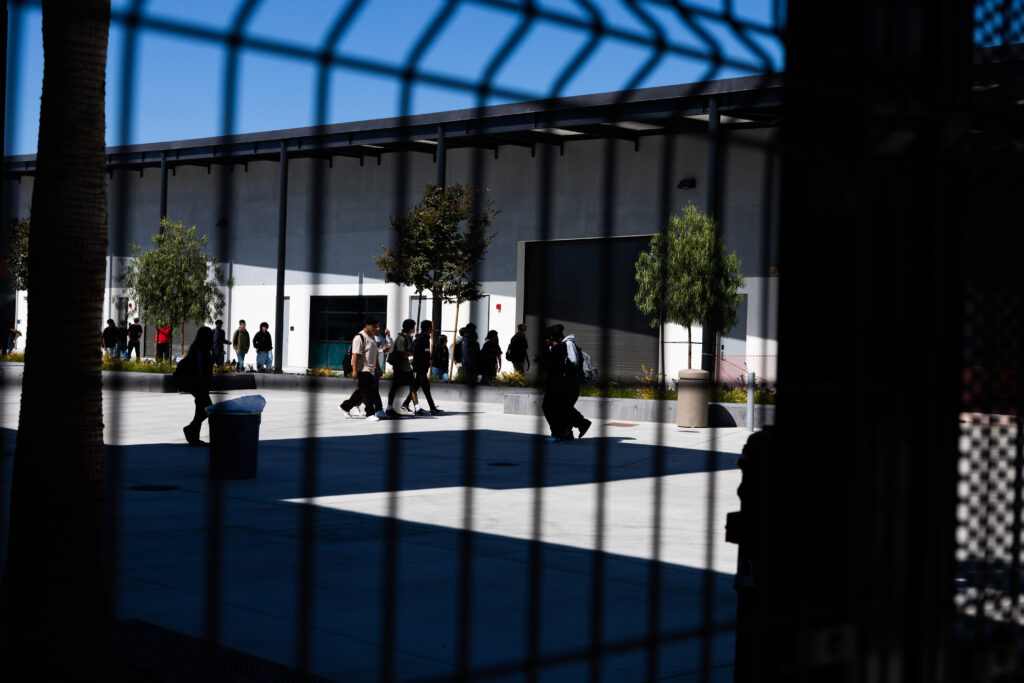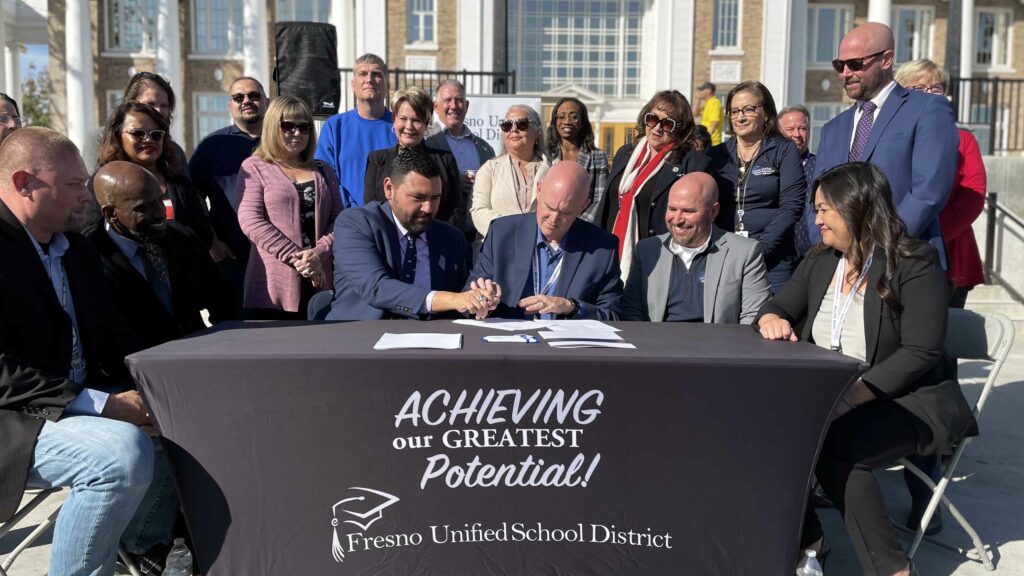
Children visit a gallery to learn about bugs by making art projects in Merryl Goldberg’s class at Cal State San Marcos.
credit: Merryl Goldberg
Eric Engdahl once ran away to join the circus. Always one with a flair for the dramatic, he became a ringmaster at Circus Flora, a one-ring boutique circus with a Civil War theme. He says the experience, learning to communicate with gymnasts and clowns, elephants and horses, prepared him well for the challenge of being a teacher.
“There was no one common language,” said Engdahl, now professor emeritus in the department of teacher education at Cal State East Bay. “So I learned how to build communication, how to tell stories, and that a common goal is essential.”
Helping students find their creative voice is a key reason Engdahl spearheaded an online credential program in theater and dance at Cal State East Bay in 2021, making it the first CSU to offer those credentials just as Proposition 28 promises to create thousands of new arts teaching jobs at California schools. Similarly, Cal State San Marcos will soon become the first CSU to create a pathway specifically for undergraduate art majors who wish to teach. Cal State Northridge is poised to launch a dance credential program next spring. Given the anticipated demand for newly minted arts educators in the wake of Proposition 28, the state’s 2022 groundbreaking initiative to bring arts education back into schools, many expect other campuses to follow their lead.
“I would like to claim that I was prescient about Prop. 28, and while I did a lot of groundwork to get the credentials going, there is always the unexpected, e.g. Covid,” said Engdahl, who wrote his dissertation on the antebellum circus movement in America. “It turned out to be great timing.”
Merryl Goldberg, a longtime music professor, has long seen arts education as an equity issue. She believes that all students should have access to the arts, not just the privileged ones, particularly because of the well-established links between arts education, academic achievement and social-emotional learning. That’s what inspired her to launch the state’s first undergraduate pathway to arts education at Cal State San Marcos.

credit: Albert Rascon
Musicians jam during Merryl Goldberg’s arts education class at Cal State San Marcos.
“We have the most wonderful diverse students at CSUSM, who I know will make incredible arts teachers,” said Goldberg, a saxophonist who spent 13 years on the road with the Klezmer Conservatory Band. “It kills me that so many students in California have had a limited arts background, and I’m thrilled this will finally change. The arts truly matter.”
Engdahl’s students are now reaping the benefits of his fortuitous planning efforts. They are sitting in the catbird seat as many school districts are clamoring to hire arts educators to teach classes funded by the state’s historic mandate to restore arts and music education to California schools. Last year, an LAUSD official visiting his theater credential class offered jobs to all his students.
“I regularly get phone calls and emails from people all over the state wanting to recruit my students,” said Engdahl. “Los Angeles, San Francisco, and to some extent, San Diego, the big districts are all aggressively implementing Prop. 28 and hiring people to fill those jobs.”
Goldberg is also hearing from school districts eager to hire arts educators. Some are having to recruit out-of-state teachers to fill the slots, she says.
“This opens up the world to so many students who want to be an art teacher, a music teacher, a dance or theater teacher,” said Goldberg. “It’s especially important for first-generation college students. The majority of our students are first-generation, and many are low-income. They have to work so hard to go to college, and they are beaming with potential to make a difference. They have so much passion.”

credit: Albert Rascon
A student in one of Merryl Godberg’s music education classes at Cal State San Marcos.
One major concern is how best to widen the arts credential pipeline, which has shriveled amid decades of cutbacks, for the next generation of arts ed teachers. While there are 64 programs in the state that offer a music credential and 57 that offer a visual arts credential, only a few focus on theater and dance. That’s not enough to feed a field that has gone from famine to feast, experts say.
“We know we’re short about 15,000 arts teachers in the state,” said Goldberg. “Most of the CSUs or UCs or even private colleges haven’t been churning out a lot of art and music and dance and theater teachers because there haven’t been a whole lot of jobs. Now, all of a sudden, there’s so many jobs.”
Despite this arts teacher crunch, there are various workarounds. For instance, physical education teachers who were credentialed before 2022 already have dance embedded in their credential, experts say. The same goes for some English teachers automatically having a theater credential. Prospective arts educators with sufficient college credits in their discipline can also apply for a supplemental authorization to teach instead of getting a credential.
It should be noted, however, that not all districts are anxious to raise the curtain on new arts programs. The myriad complexities of the Proposition 28 rollout may have contributed to many smaller and rural districts proceeding cautiously as they expand their arts offerings.
“The rural districts are not as well-resourced due to fewer students,” said Letty Kraus, director of the California County Superintendents’ statewide arts initiative, “and it is harder to staff rural schools with credentialed arts teachers due to shortages.”
In the wake of the Covid pandemic, many school administrators are also overwhelmed by pressing matters, experts say, from the dearth of teachers to deep learning loss, marked by falling rates of literacy and numeracy.
“Elementary principals don’t have time to deal with this,” said Engdahl. “You’re already struggling to hire teachers. You’re looking to fill classrooms, you’re doing a lot of jobs and there’s not enough administrative support.”
Some districts, having eliminated their arts classes long ago due to budget cuts, are now starting from scratch with no expertise in the arts. They need help to build out a plan for arts education, and some arts advocates note the California Department of Education, which is administering the program, has not been sufficiently responsive regarding the rules of implementation.
“Many school districts are taking a go-slow approach,” said Engdahl, who is consulting with several districts on how to flesh out their programs. “They want to wait and see how the money flows. They don’t know quite what to do with it because they don’t have enough administrative staff to figure it out.”
A slow-and-steady approach might make sense, some say, because schools have three years to use the funds. A little extra time also means that more colleges can get in on the act and develop their own arts credential programs to help fill the burgeoning pipeline.
“You have to take the long view,” Goldberg said. “It’s not a bad idea to hold off and not rush into things. That gives you time to really look at the language of the law. It also gives colleges time to launch new programs to widen the pipeline. My team feels confident our work is 100% replicable among any of the CSUs, private colleges and UCs.”
Cal State San Marcos plans to welcome its first arts education cohort next fall. Goldberg says there’s been a lot of demand thus far from both arts-focused undergraduates who want to teach their craft and from seasoned teachers interested in transitioning into arts education.
“We are reaching out to teaching artists who may wish to come back to get a credential, and to in-service teachers who have already or might soon transition to becoming an arts teacher,” she said. “We want to ensure they have the support and training they need. There is an extreme need for new arts teachers and support for transitioning teachers.”
She also argues that California offers many career opportunities for graduates with arts expertise, from arts education and the entertainment industry to the exploding cybersecurity sector, which has been known to recruit music majors for their ability to construct complex elements into intricate patterns.
“The amount of jobs relating directly to the arts is crazy,” said Goldberg. “Arts ain’t fluff, they really are a career opportunity. The importance of arts in preparation for careers is giant.”
For his part, Engdahl is hopeful that as the new arts mandate rolls out, more districts will see that arts education could also be a powerful tool for healing children traumatized by the pandemic.
“The arts and arts education, because of the way it’s taught, could really be a wonderful resource for helping students heal from the pandemic and catch up with the developmental and the social skills that they lost,” he said. “I think probably many administrators know that, but it’s just they’re so overwhelmed with what’s going on in the trenches right now.”






















